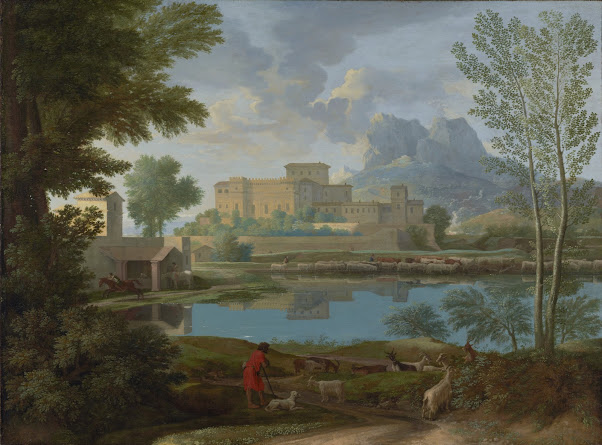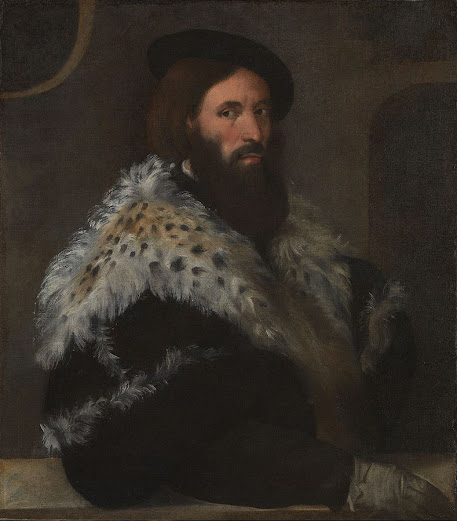Early Modern Analysis
Oh boy it's Early Modern time. Now we get into some of the most detailed pieces right alongside the ones that only make sense if you stare at them upside down for an hour. But lets get started!
(Contra-Construction Project (Axonometric) By Theo Van Doesburg, 1923, likely in Paris)
First up we have De Stijl, or "the style" in English. This style was born both as a response to contemporary accepted art styles and a way to impose geometric order after some artists' experiences with the chaos and asymmetry of WWI. Doesburg believed that artistry and architecture had one major intersection: the flat plane. This piece was a mock-up drawing of a custom house that was never commissioned. The art elements of De Stijl paintings were very limited; they used only the primary colors plus black and white, and usually limited themselves to rectangular planes to express ideas. We can see all of those elements above, but given an abstract three dimensional form.
I chose this piece for De Stijl because it had some sort of three dimensional form, as opposed to other pieces which just show a haphazardly arranged collection of... regular rectangles. I'm altogether underwhelmed by this style of art, and I imagine it as the type of thing one would find framed at a dentist's office right next to a similar size frame of a polar bear photograph. I just don't get enough of a story from rectangles.
(Not to be Reproduced by Rene Magritte, 1937, Brussels, Belgium)
Not to be Reproduced is a painting commissioned by Edward James for his home. The painting depicts a man standing in front of a mirror, and while the book is reflected, we still only see the back of the subject reflected in the mirror. James modeled for the painting, and it is considered to technically be a portrait of him, despite not showing his face.
The surreal style came into existence from the Dada movement, which itself was known to be born of a group escaping from the horrors of war. In this context, it isn't very surprising that all concerns of reality were left unaddressed. Surrealism is known for it's representations of dream landscapes, and juxtaposition of random objects. The style as a whole tends to drift towards a sense of unease, sometimes spun for volatile dreaming fun, but also sometimes leaning into unnatural dread. While this piece might not inspire any dread or fear, it is worth noting that the book depicted is a copy of a book by Edgar Allen Poe, a notoriously spooky poet.
As for me, I enjoy the nonsensical juxtapositions. It tickles my brain to see them almost as much as it does when I use juxtaposition in a sentence and know what it means. The art elements are not substantially different from any other previous non-geometric art, but some of the more well-known artists of the surrealist style were known for using more pastel shades in their work.
Gassed is a large scale painting that is thought to portray the aftermath of a German mustard gas attack at Le Bac-du-Sud during the second battle of Arras in 1918. It depicts a line of British soldiers, blinded by gas, being led by medical orderlies. Dead and wounded soldiers are shown lying on the ground to the sides of the wooden walkway. The painting was large enough that the soldiers standing in the line in the foreground were supposed to be life-sized renditions.
John Singer Sargent was an American painter commissioned by the British War Memorial to find examples of American troops and British troops working together. In the chaos of the war, the only time he was able to find American and British troops interacting was on the back line in the hospitals. After returning to the UK from tour, the War memorial allowed him to change the subject of the commission.
This painting is known as John Sargent's masterpiece, and expertly depicts the quiet horrors that occurred in the great war. It was made in the American mural style made popular during WWI and into the WPA's portion of the new deal, largely identified through the size and proportions of the painting. The blinding effects of mustard gas were temporary for most, but caused permanent injury and death in others. The yellow cast to the sunset in the painting only seems to add to the sickly feeling of the entire painting.
The painting was criticized by some as overly patriotic, as Western audiences are shown and told disproportionately many stories about German gas attacks. In fact, both sides of the war extensively used gas weapons. France and Germany were infamously in a race to improve their respective weapons fast enough to deploy them en masse.
The American Mural style is something that I would consider incredibly varied in its subject, so my decision on whether to own a mural style painting would be highly dependent on circumstances.
References
"De Stijl Movement Overview." TheArtStory, https://www.theartstory.org/movement/de-stijl/, Accessed 4 April, 2024
Gabrielka. "Not To Be Reproduced, 1937." WikiArt, last edited 13 October, 2023, https://www.wikiart.org/en/rene-magritte/not-to-be-reproduced-1937, Accessed 4 April, 2024
"Theo Van Doesburg, Cornelis Van Eesteren." MoMA collection, 2019, https://www.moma.org/collection/works/232?sov_referrer=art_term&art_term_id=29, Accessed 4 April, 2024
"World War 1 And American Art." Pennsylvania Academy of the Fine Arts, https://www.pafa.org/museum/exhibitions/world-war-i-american-art, Accessed 4 April, 2024


_-_Gassed_-_Google_Art_Project.jpg)


I found the artworks you chose for your early modern blog intriguing, and I must admit that I like them all. My favorite was, without a doubt, Not to be Reproduced by Rene Magritte 1937 and, currently housed in Museum Boijmans Van Beuningen, Rotterdam, Netherlands. It is a surrealistic painting and ties in nicely to the WWI theme. I found the artist's psychological approach to the post-war existentialism crisis. The juxtaposition between the expected reflection of the gentleman's face and the depiction of his back is unsettling and disturbing. Especially considering that the reflection of Edgar Poe's book The Narrative of Arthur Gordon Pym of Nantucket is correct.
ReplyDeleteRene Magritte served in the Belgian infantry in the Flemish town of Beverlo from December 1920 to September 1921.
Most of Magritte's dogs were named LouLou.